You
can also view the message online

Châtenay-Malabry (FR - 92290), October 17, 2022
EFITA newsletter / 1060 - European Federation for Information Technology in Agriculture, Food and the Environment
The informatique-agricole.org site offers you the possibility of subscribing the RSS feeds of its two newsletters
See RSS feeds to implement to ensure that you continue to receive this newsletter
To unsubscribe this newsletter, please contact me directely: guy.waksman(a)laposte.net if this link Unsubscribe does not work.

To correspond with me (GW), please use this address: guy.waksman(a)laposte.net
To subscribe the efita newsletter (please ask your friends and colleagues to test this link)
Efita Newsletters subscription
Before computing : Machines agricoles R. Wallut et Cie, vers 1920
Weekly newsletters about ICT in Agriculture in English and French
Both newsletters have around 10000 subscribers.
>>> Last weekly EFITA Newsletters in English (created in 1999) Efita Newsletters
>>> Last weekly AFIA Newsletters in French (created more than 20 years ago in 1997) Afia Newsletters
>>> Statistics for the latest efita newsletter
>>> Last issue of the afia newsletter
>>> Last available satistics for the afia newsletter
Paysage en Provence, Martigues, ca. 1908, par André Derain
| 01 - 13/10/22 |  |
Building a European framework for the secure and trusted data space for agriculture
AgriDataSpace project aims to pave the way for a European data space for agriculture that facilitates data sharing, processing, and analysis in a secured, trusted, transparent and responsible manner to create new opportunities for monitoring and optimising natural resource use stimulating data-driven innovations.
Key Objectives:
- Map the current landscape of on-going data sharing initiatives and design approaches in agriculture.
- Analyse and assess current governance models and develop a multi-stakeholder governance scheme for the EU data space for agriculture.
- Analyse and assess current business models and explore potential business models for various stakeholder relations.
- Explore the evolving legislative framework and provide solutions and technical enablers for ethical tensions related to data sovereignty
- Develop a conceptual reference architecture for a common data space framework in agriculture and a reference technology canvas.
- Engage stakeholders in various activities for evaluation and validation in order to reach broad consensus.
- Develop a roadmap that compiles all requirements into a comprehensive pathway towards implementation of the EU data space for agriculture
See agridataspace-csa.eu
Contact: Sebastien PICARDAT
E-mail: sebastien.picardat(a)agdatahub.eu
Landscape near Chatou, 1904, by Andre Derain
| 02 -13/10/22 |  |
How did we see the future yesterday??
See the incredible collection developed by Alain Fraval
Archives of our newsletters in French and English
Voir Afia
Voir Efita
15-year-old violinist Henry Auxenfans and From the Top Host/pianist Peter Dugan perform “Caprice d’après l’étude en forme de valse de Saint-Saëns by Eugène Ysaÿe”
Listen to an excellent young musician
FutureFarming.com
> Artificial intelligence to command autonomous John Deere machinery
Brazilian start-up FieldPRO is developing artificial intelligence that uses environmental data to send commands to autonomous John Deere machines.
> Storage technology: Good vibrations – Drying grain with radio waves
For Minnesota-based company Dry Max Solutions, radio waves offer an alternative method for drying grain free of both petroleum expenses and heat.
> Satellite imagery: DataFarming aims to offer growers cheap and easy access to satellite imagery
DataFarming has developed a web application that delivers satellite imagery to any farmer in the world.
> Harvesting robots: Strawberry-picking robot uses ultra violet light to control funguses
Australian company BSC Electronics in Perth has developed a strawberry-picking robot, that uses ultraviolet light to control funguses on strawberries, reducing the need to use fungicides.
> Expert opinion: Will technology to develop sustainable IPM systems reduce agrochemical dependence?
Will new ag tech enable farmers to farm sustainably and concurrently reduce their agrochemical dependence?
> Small electric tractor developed by Keestrack
Belgian machinery manufacturer Keestrack developed an electric tractor. The Keestrack B1e offers a rated power of 54 hp (40 kW) and a maximum power of 87 hp (64 kW).
> Expert opinion: How new technology can help farmers survive increasing droughts
Drought conditions are expected to continue, and along with them the pressure on growers to conserve, report, and adapt.
> GPS: John Deere Autopath improves accuracy of GPS lines between operations
John Deere AutoPath allows an additional GPS receiver on an implement to automatically create GPS lines for the next operation.
> Storage technology: Good vibrations – Drying grain with radio waves
For Minnesota-based company Dry Max Solutions, radio waves offer an alternative method for drying grain free of both petroleum expenses and heat.
> Autonomous equipment: Artificial intelligence to command autonomous John Deere machinery
Brazilian start-up FieldPRO is developing artificial intelligence that uses environmental data to send commands to autonomous John Deere machines.
See FutureFarming.com
Montagnes à Collioure, par André Derain
| 03 - 13/10/22 |  |
Update: Wild mammals are making a comeback in Europe thanks to conservation efforts
We originally published this article in May 2022. We updated and republished it in September 2022 based on the new 2022 edition of the report.
The European bison, the continent's largest herbivore, was once abundant across the region. But over time, deforestation and hunting caused its numbers to decline dramatically. By the early 20th century the European bison had gone completely extinct in the wild, with only tens of individuals surviving in captivity.
The bison is no outlier, and many other animals have suffered similarly. But it doesn’t have to be this way—and the bison shows it.
The European bison has made an impressive comeback over the last 50 years. Successful conservation efforts have seen their numbers rebound, and Europe is now home to nearly 10,000 of them.
In this article, we look at the change in mammal populations across Europe and find that many species are making a comeback. Once on the brink, iconic animals such as the European bison, Brown bear, and elk are thriving once again.
| See
ourworldindata.org 13/10/22 |
 |
Q3 2022 AgTech Venture Capital Investment and Exit Round Up
While AgTech VC investments slowed last quarter, agriculture stood up far better than most industries in terms of overall venture funding.
See globalagtechinitiative.com/
The Inaugural VertiFarm Showcases Next-Level Farming and New Food Systems
The event in Germany highlighted products and approaches for addressing global issues such as security of supply, crop failures, and urban sustainability.
See globalagtechinitiative.com/
Road Among the Olive Trees, by Andre Derain
| 04 - 13/10/22 |  |
Precision Sprayer Company Smart Apply Raises $3.1 Million to Accelerate Adoption
Funding to accelerate sales and manufacturing of its Intelligent Spray Control System in advance of the 2023 growing season.
See globalagtechinitiative.com/
Opinion: AgTech Offers the Labor Upgrade Our Industry Needs
Hands-on fieldwork in agriculture is not going anywhere, but it is due for an upgrade to make the whole industry operate with more efficiently.
See globalagtechinitiative.com/
COVID-19 update
Explore our multimetric views of COVID data: These views allow you to compare multiple metrics across many countries at the same time.
- Cases and deaths
- Cases, tests, positivity rate, and reproduction rate
- Vaccine doses, people vaccinated, and booster doses
- Vaccine doses and deaths
- Vaccine doses, cases, ICU patients, and deaths
- Cases, hospital admissions, ICU patients, and deaths
- Deaths and excess mortality
| See
ourworldindata.org 13/10/22 |
 |
Solinftec Celebrates 15 Years in the Ag Tech Space -- But Here's Why the Company Has its Eyes on 2050
The time to start thinking about 2050 is now. Solinftec, a global leader in agricultural digitalization, is doing just that.
See globalagtechinitiative.com/
Sous-bois, par André Derain
| 05 - 13/10/22 |  |
Robots are making French fries faster, better than humans
Fast-food French fries and onion rings are going high-tech, thanks to a company in Southern California.
Miso Robotics Inc in Pasadena has started rolling out its Flippy 2 robot, which automates the process of deep frying potatoes, onions and other foods.
A big robotic arm like those in auto plants - directed by cameras and artificial intelligence - takes frozen French fries and other foods out of a freezer, dips them into hot oil, then deposits the ready-to-serve product into a tray.
.../...
See reuters.com
Moving from at-risk cities because of climate change
| 01
- 13/10/22 |
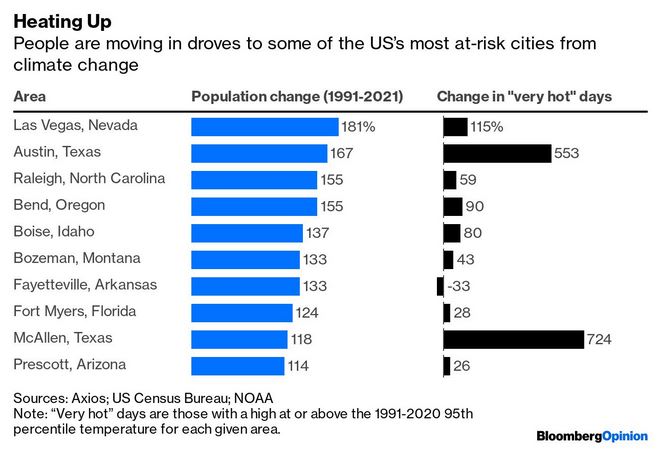 |
Risk or no risk?
| 02 - 13/10/22 | 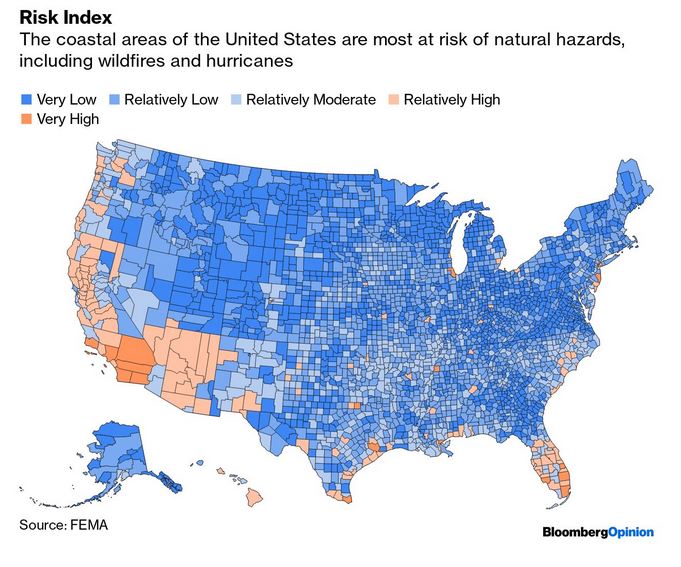 |
How John Deere plans to build a world of fully autonomous farming by 2030, CNBC, by Bob Woods
- Deere & Co., well known for its green and yellow tractors, bulldozers and lawnmowers, has spent nearly two decades investing in technology and robotics.
- That has culminated with a fully autonomous version of the 8R farm tractor that does not require someone to be behind the wheel.
- However, while Deere is aiming to push further into other autonomous farm vehicles and other technology-aided advancements, the global fleet of such vehicles is currently less than 50.
.../...
Not surprisingly, Deere’s biggest competitors have been developing automation and autonomy for its farm machinery, too. AGCO, whose brands include Massey Ferguson and Fendt, “has been automating farming operations since the mid-1990s,” said Seth Crawford, senior vice president and general manager of the Duluth, Georgia-based company’s precision agriculture and digital division. “We’re at a stage we call supervised autonomy, where we still have someone in the cab of the machine,” he said. “The buzz is around fully autonomous operations, but where farmers are willing to pay for automation is feature by feature.”
Whereas Deere is focused on adding full autonomy to its own farm equipment, AGCO is eying the wider retrofit market, Crawford said. “In summer 2023, we’ll have a performance-enhancing retrofit kit available for multiple brands of machines,” he said. “Where others say we bring you autonomy with a half-million-dollar tractor,” he said, alluding to the price tag of Deere’s 8R, “we have kits that allow you to do that with your existing fleet. We see a huge opportunity with the installed base, where farmers want to adopt technology to enhance their outcomes, and yet don’t want to flip their entire fleet and make that massive investment.”
In 2016, Case IH, a subsidiary of CNH Industrial, headquartered in London, rolled up to the Farm Progress Show with what it called the Autonomous Concept Vehicle. The sleek prototype tractor, minus a driver’s cab, hinted at the view of autonomy at the time. Fast forward six years, to September’s Farm Progress Show, where Case IH unveiled its Trident 5550 autonomous applicator.
The Trident 5550 is designed for spreading materials in farm fields. Retrofitted with autonomous technology developed by Raven Industries, which CNH acquired for $2.1 billion in June 2021, the enhanced Trident employs self-driving, advanced cameras and AI to interpret a continuous stream of images to detect obstacles.
Released in 2017, the Trident 5550 — with a cab — is designed for spreading dry and liquid materials in farm fields. The model at the farm show was retrofitted with autonomous technology developed by Raven Industries, which CNH acquired for $2.1 billion in June 2021. Similar to Deere’s autonomous 8R, the enhanced Trident employs self-driving capability, advanced cameras and AI to interpret a continuous stream of images to detect obstacles.
The company plans to have a limited number of the machines ready for farmers to test before going to market perhaps next year, said Chris Dempsey, global director at Case IH Precision Technology, though the exact release date is to be determined. “We want to get customer feedback and understand their confidence level [in autonomy] before we go commercial,” he said.
See cnbc.com
Meet the founder: How Doaa Abdel Hameed pivoted her food delivery startup to a “super-app”, AFN, by Lucy Ngige
“There comes a time where the path of your career life has to change.”
Doaa Abdel Hameed was working in people and operations management in the food delivery industry when she and her co-founders saw a gap in the market for a single app to deliver multiple but closely related services to customers. Personally she also felt it was time to make the next step in her career, too.
Earlier this year, she cofounded Bonbell, which began as an app for food ordering and delivery with the intention to eventually branch out into those other services.
So far, Egypt-based Bonbell has worked with 400 merchants and aims to increase that number to 750 by the end of 2022. The company is also now creating a “super-app” to serve clients in different locations like sports clubs, universities, hotels, and corporate buildings. Merchants on the platform offering services such as food ordering, hotel booking, cinema booking, and more can either pay subscription fees or a commission to Bonbell according to their preference.
Bonbell has already raised $550,000, including a round this summer secured from a Canadian angel investor.
AFN spoke to Hameed (DH) about her vision for building a multi-service app to serve clients not just in North Africa, but the wider MENA region and Asian markets where the team is conducting research.
See agfundernews.com
Stormy weather: more and more storms, tropical cyclones...
| 03 - 13/10/22 | 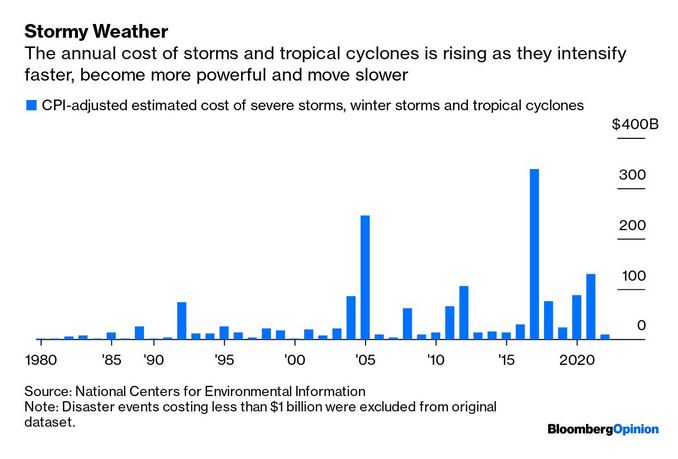 |
Costly hurricanes
| 04
- 13/10/22 |
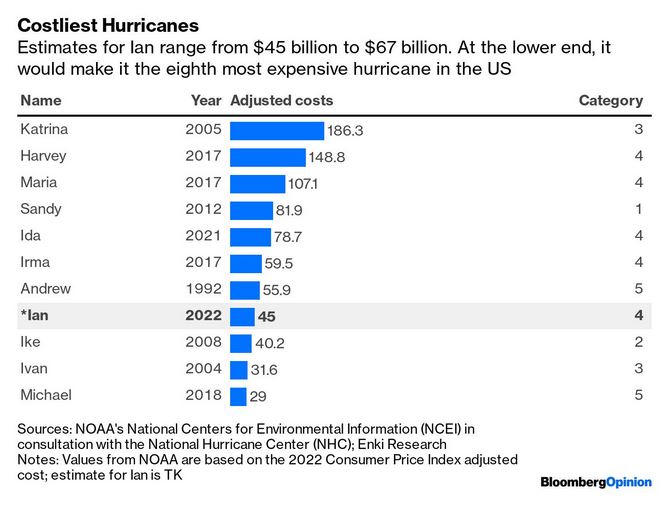 |
After billions in investment, plant-based meat is a branding catastrophe, AFN, by guest contributor: Adam Hanft
Radical innovation can be its own brand.
For a while. For a minute.
If you’re selling a revolutionary capsule that transports you anywhere in the world, in 30 seconds, you don’t need to say more than that.
It’s what I call the “Declarative Moment.” A simple statement of being.
But soon, 15 companies will be marketing that capsule. You’ll need to differentiate.
Your box is more accurate, for instance. It can bring you precisely to the restaurant you want in Paris, not plop you a mile away.
It does less damage to your immune system.
It comes with discounts at the Ritz.
You get the idea.
That has been the history of technological innovation. Take the initial advertising for the telephone – focused on the simple ability to make calls.
It didn’t take long, though, for the Northern Electric Company, and others, to start marketing product distinction. Rapid and inevitable maturity.
The same pattern applies to the ongoing evolution of voice transmission: the cell phone. At the beginning, it was the basic “The Future Is Here” strategy.
We’ve come a long way, obviously, as Apple and Samsung fight it out over a combination of brand perception and features.
That brief expedition through the inexorable cycles of technology marketing brings us to what you, dear readers of AFN, are most interested in.
The marketing of plant-based foods.
We have long moved past the declarative moment; Beyond Meat launched in 2016 in Whole Foods and announced deals with Dunkin Donuts and McDonalds in 2019 and 2020.
Impossible Foods launched in 2016 with Burger King.
But the market has become crowded and noisy; the novelty has vaporized; and growth has slowed so much that Beyond Meat’s share price has cratered beyond belief, from a high of $109 to around $16 as I write this.
What’s happened? You can debate whether these are truly technological triumphs, but there is no doubt that they are marketing catastrophes.
There is zero differentiation or branding in the space; all the players are stuck in Motorola Land, going no further than saying “we are plant-based.”
This is marketing malpractice – giving plant-forward consumers no reason to consume your soybeans over someone else’s.
Impossible Foods commits the same felony. Interestingly, they are still speaking to vegans who are motivated by the plant provenance. Rather than the broader market – including flexitarians – who want to reduce meat consumption but still lust for hedonic gratification. Those are the
Tyson, who jumped into plant-based when they saw the trend – and didn’t want to become the Kodak of protein and suffer the Innovators Dilemma by clinging to their meat legacy – is also failing to differentiate. They are selling plant-based as a commodity just like the start-ups.
Two smaller companies – Tattooed Chef, who is public and whose stock is also suffering mightily – and No Evil Foods (Disclosure: I am an investor, although I am not exactly boosting them) are also worth noting.
.../...
See agfundernews.com
Trees and Village, c. 1932, by Andre Derain
| 06 - 13/10/22 |  |
Biden Issues Executive Order Promoting Agriculture and Food Biotechnology, by Gregory Jaffe, October 3, 2022
On September 12, 2022, President Biden issued an “Executive Order on Advancing Biotechnology and Biomanufacturing Innovation for a Sustainable, Safe, and Secure American Bioeconomy.” This “National Biotechnology and Biomanufacturing Initiative” seeks to advance U.S. biotechnology and biomanufacturing to provide innovative solutions in “health, climate change, energy, food security, agriculture, supply chain resilience, and national and economic security.”
Some of its goals are to increase biomanufacturing capacity in the U.S. (hopefully leading to lower drug prices), boost biomass production (which is renewable or recurring biological materials such as plant and tree material and animal and food waste), and educate the next generation of scientists and engineers in bioeconomy disciplines. While much of the Executive Order stresses health, medicine, energy and biological data, there are specific sections that apply to agriculture and food.
.../...
See allianceforscience.cornell.edu
Paysage du Midi, c. 1932, par André Derain (1880-1954)
| 07 - 13/10/22 |  |
"We produce enough food to feed 1.5 times the global population", Thin Ink
But the system is not working for vulnerable communities, says chair of UN Committee on Food Security.
Now, most people outside of the food aid/development bubble wouldn’t have heard of the Committee on World Food Security (CFS) but you should because well, it’s dealing with the governance of something that is literally the difference between life and death - the food that nourishes and sustains us.
CFS was established in 1974 as an inter-governmental body and born out of the food crisis in the early 1970s. Its path hasn’t always been smooth and it embarked on an ambitious reform programme after the 2007-2008 food crisis.
It’s still not perfect but it is one of the few global bodies that brings in all stakeholders - civil society, farmer groups, the private sector, governments, financial institutions, UN agencies, academics and researchers - to work on food security issues.
There continue to be debates around its existence and role - see my stories here and here over what civil society saw as attempts to supplant it at last year’s Food Systems Summit - as we grapple with yet another food price crisis amid an ongoing pandemic, conflicts, and climate change.
.../...
I commend the work done by media around the world to raise public awareness on the crisis and hold those of us in leadership accountable.
What I would now like to see more of is greater call for long-term transformation of our food systems to deliver food security, adequate nutrition and healthy diets for all people, while providing decent jobs and incomes to family farmers and food producers.
These diets must be carbon neutral, reverse biodiversity loss, and restore ecosystems. The UN Food Systems Summit convened in 2021 by the UN Secretary-General gave us the momentum for this transformation.
See news.thin-ink.net
Very strong US dollar
| 05 - 13/10/22 | 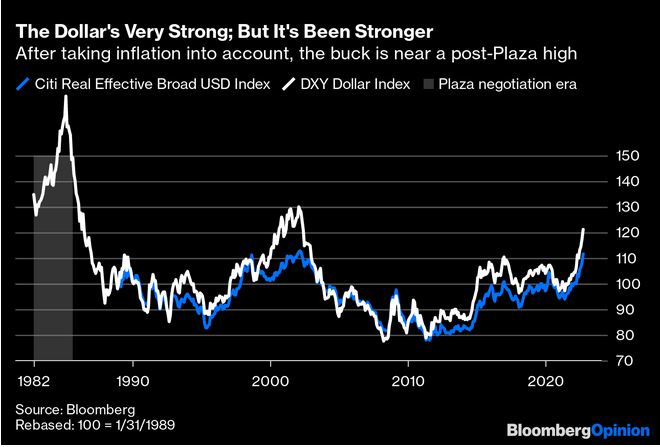 |
Moving to at-risk cities fromclimate change
| 06 - 13/10/22 |  |
Does open source agtech make sense? Easy Observations, by Nathan Faleide
| See easyobservations.substack.com | 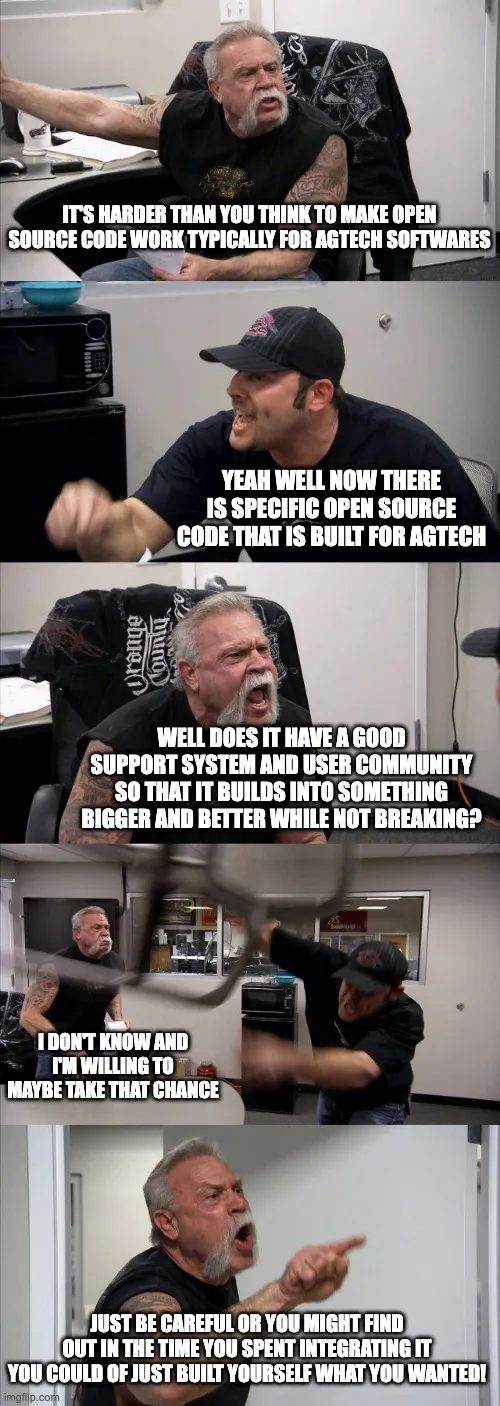 |
How Deep Science Ventures aims to build resiliency in tropical agriculture, starting with Costa Rica, AFN, by Jennifer Marston
Tropical regions cover roughly 40% of the earth’s surface and are home to about 40% of the world’s population. Nowadays, these regions also bear some of the worst impacts of climate change in the form of rising temperatures, floods and extreme changes in the weather. All of this affects tropical agriculture, food production, and the livelihoods connected to it.
London-based venture creator Deep Science Ventures (DSV) is in the midst of trying to build more resilient agricultural economies in these regions, starting in Costa Rica.
The firm recently teamed up with Costa Rica’s CRUSA Foundation to launch the Tropical Agriculture & Bioeconomy Initiative (TABI). The national program will create agrifoodtech companies to help push Costa Rica’s economy towards decarbonized, regenerative, and circular bio-economies. The concepts and models designed in this program will ideally be applicable to other tropical regions of the world in the near future.
“The goal has been to figure out how to start companies at Deep Science Ventures, but then to make a landing pad to start bio-economy companies in that wider Latin American region,” Edward Perello, associate director for agriculture at DSV, tells AFN.
.../...
See agfundernews.com
Risk or no risk?
| 07 - 13/10/22 |  |
Stormy weather: more and more storms, tropical cyclones...
| 08
- 06/10/22 |
 |
Plant-based proteins are too expensive, Foreign Policy, by Nigel Purvis and Bruce Friedrich
…/…
As the world grows, develops, and warms, our reliance on conventionally produced animal protein increases food prices, makes our food system more vulnerable, and exacerbates climate change. And with demand for meat set to rise inexorably for decades, these external costs will only increase. The growth of renewable energy and the emerging success of electric vehicles have shown that the global economy can transition in ways that spur economic growth, create new jobs, and add choices for consumers. Moreover, as growing demand for electric vehicles makes clear, this transition can happen even in the face of long-standing cultural preferences. With strong domestic leadership and global cooperation, protein innovation can be the next big step that nations take toward a vibrant, secure, and green economy.
See foreignpolicy.com
Le village de Dammarie-en-Montois, ca 1935, par André Derain
| 08 - 13/10/22 |  |
|
Gazette
de vitisphere.com, |
A first thought for today
Half of the harm that is done in this world is due to people who want to feel important. They don't mean to do harm, but the harm does not interest them.
T.S. ELIOT, poet (1888-1965)
A second thought for today
There may be times when we are powerless to prevent injustice, but there must never be a time when we fail to protest.
Elie WIESEL, writer, Nobel laureate (1928-2016)
A third thought for today
No protracted war can fail to endanger the freedom of a democratic country.
Alexis DE TOCQUEVILLE, statesman and historian (1805-1859)
Costly hurricanes
| 09 - 13/10/22 |  |
Analysis: Asia's southern flank shines in fight vs surging dollar, by Tom Westbrook and Rae Wee, September 8, 2022
| See
reuters.com 13/10/22 |
 |
Very strong US dollar
| 10 - 13/10/22 |  |
Fast-melting glaciers in the Himalayas
Scientists have been collecting data on the glaciers in the high mountain ranges that run across Central and South Asia for the past 20 years to track how their size and mass has changed over time. By the end of the century, between one- and two-thirds of the region’s glaciers could melt, largely driven by atmospheric warming. This could have far-reaching consequences for the more than one billion people who depend on the river systems that are fed by the snow and glacial melt. Increased melting could erode banks, trigger landslides and catastrophic floods when glacial lakes break their banks, and make water supplies for irrigation unpredictable.
See e360.yale.edu
Covid-19 in France and UK (Emmanuel vs Boris!)
| 11 - 13/10/22 | 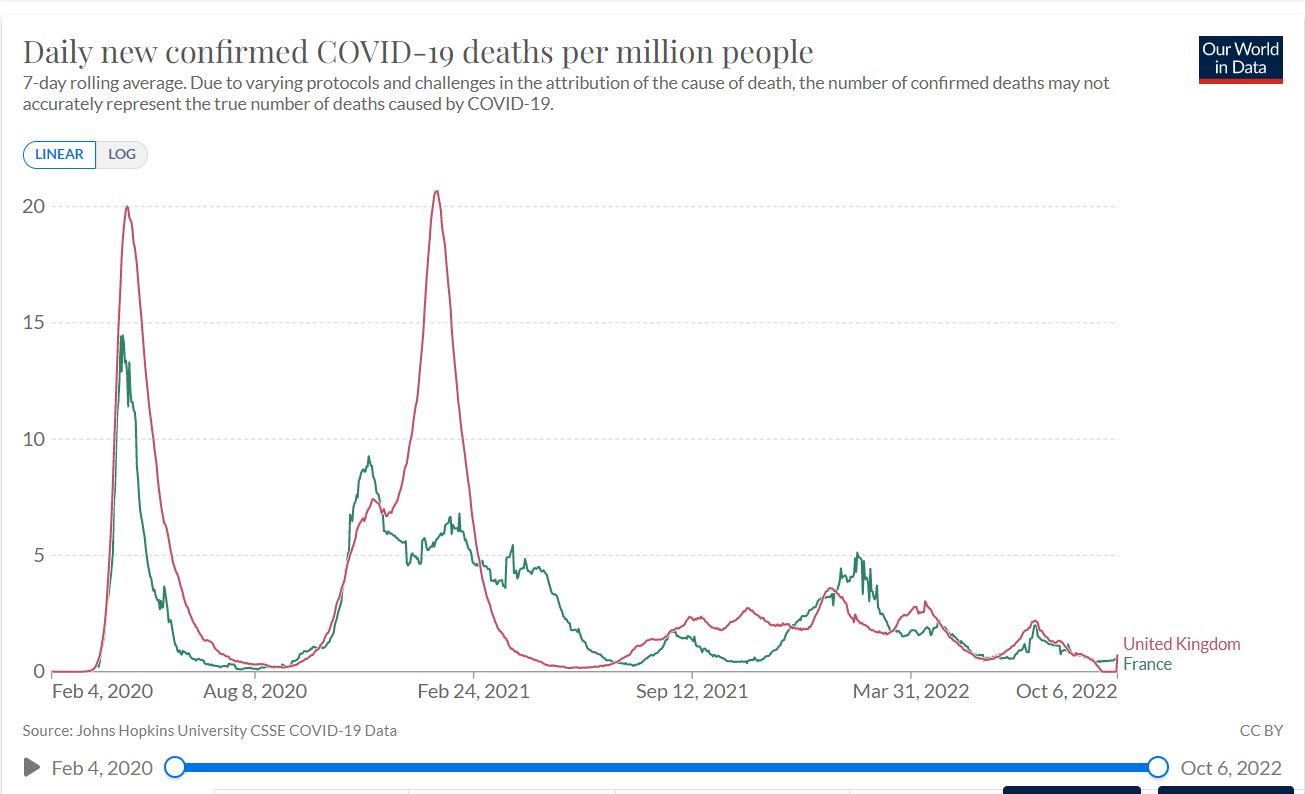 |
Last stand in the Amazon
Drug runners, gold miners and loggers are rapidly invading the remote Peruvian Amazon, home to isolated people and a wealth of biodiversity. In this rich multimedia feature, meet the researchers and Indigenous communities who are fighting to stop the destruction.
See nature.com
USA : In the Republican states, people use less than in the Democratic states, the Paxlovid, a miracle drug against the Covid-19
| 11 - 13/10/22 | 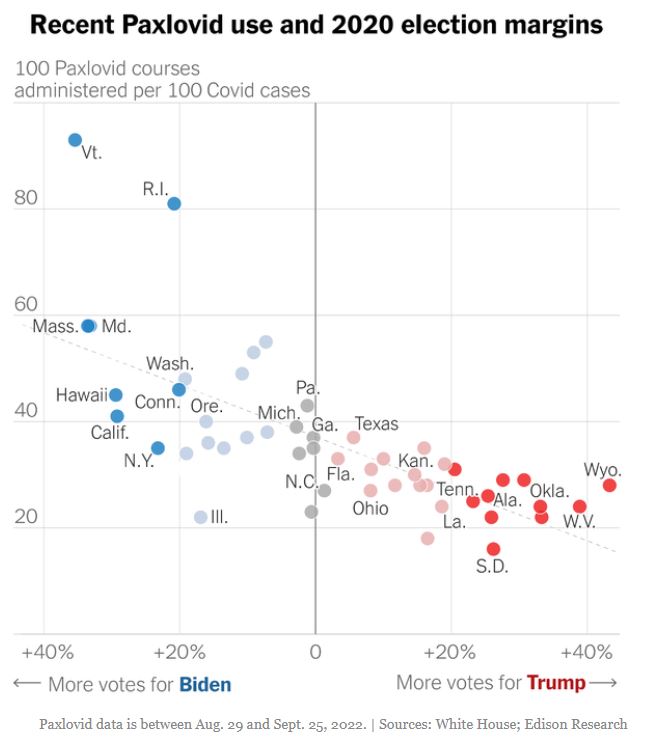 |
Playing an instrument is linked to better cognition
Another of the many benefits of a musical education.
From strumming a guitar next to a campfire to entertaining guests with a piano piece at a formal dinner, being able to play a musical instrument is unquestionably rewarding. Yet, evidence suggests that the rewards go far beyond the elation of performing well in front of others—those who play instruments have often been found to perform better on cognitive tests too.
Enhanced cognition is well-known to be linked to a range of positive life outcomes such as getting a better job and enjoying improved health. However, it has remained unclear whether these enhanced cognitive skills are just temporary. New research published in Psychological Science suggests that the benefits of musical instruments remain for decades.
Studies comparing the mental abilities of musicians and non-musicians often show that musical training is related to small, but significant, cognitive benefits even when confounding factors, such as socioeconomic status, are accounted for. Findings from experimental studies with children have also lent support to the idea that musical training might cause an improvement in cognitive ability. Indeed, there is evidence that just two years of such training enhances cognition.
Unfortunately, a major limitation of these studies is their duration. They almost always have short monitoring periods. This is not because psychologists do not yearn to monitor their participants for longer. It is more a matter of time and resources. Running experiments over the course of several decades is logistically challenging and expensive. This has made it impossible to determine if cognitive changes associated with learning how to play an instrument remain throughout a person’s lifetime.
In their latest study, Judith Okely at Edinburgh University and her colleagues, Ian Deary and Katie Overy, identified a solution to that age-old problem: the Lothian Birth Cohort. On a single day in 1947, the Scottish government tested the intelligence of almost every 11-year-old child who attended school in the country. In 1997 Dr Deary contacted 1,091 of those people and tested them once more between 2004 and 2007. The study is still ongoing with participants returning for further cognitive testing every three years.
Although information about musical ability was not initially collected as part of the study, while pondering the question of how learning an instrument shaped cognition over time in early 2017, Dr Overy, a researcher at Edinburgh University’s Reid School of Music, realised it was not too late to ask the original participants about their musical experiences.
The researchers worked together to develop a questionnaire that collected information about lifetime musical experience. This was completed by the surviving cohort members who returned to the study for further testing at age 82. The participants were asked how many instruments they played and what their training was like. They were also asked to record how many years of regular practice they had and what performance level (for example beginner, intermediate or advanced) they had reached. A total of 366 cohort members provided usable information and 117 revealed that they had some degree of experience with musical instruments.
Overall, the researchers found that a significant positive relationship existed between playing an instrument and change in cognitive ability over time. More specifically, the more years and more hours of practice with an instrument that a person had, the more likely they were to show a positive cognitive change over the course of their life. The effect was small but it remained significant even when the findings were adjusted to take into account confounding factors like years of education and socioeconomic status.
Precisely why learning to play a musical instrument has these effects remains unclear. The researchers theorise that driving people to regularly use a mix of focused attention, co-ordination, auditory-motor skills and memory results in advantageous cognitive changes. Yet another reward, then, from a love of music.
See economist.com
USA: at the start of the pandemic, the Democratic states were in a very difficult situation, then many Republicans refusing vaccines and the miracle drug that is Paxlovid, the Democratic States had at the end half more deaths...
| 13 - 13/10/22 | 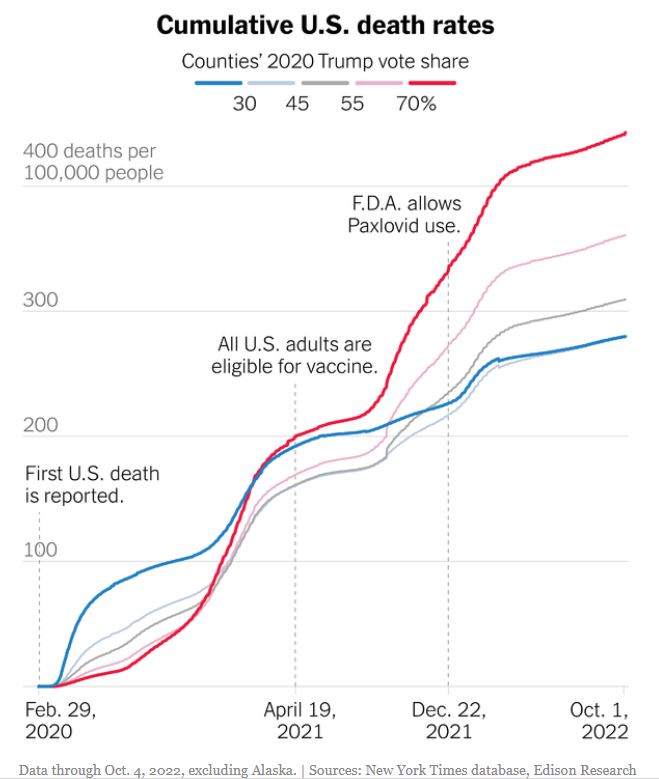 |
Our planet is abundant but finite—it only has so many atoms
However, that doesn't mean we will ever run out of resources. While humanity has a limited amount of matter at our disposal, we also have access to knowledge, which has no limits.
Just as there are an infinite number of songs you can create with the 88 keys on a piano, there is no end to the ways we can combine and arrange our precious atoms.
See humanprogress.org
Courtyard with well, by André Derain
| 10 - 13/10/22 |  |
In the birds section
I was perusing the shelves at a bookstore when a customer asked an employee where the birding section was.
After pointing it out, the employee asked,
“Is there anything specific you’re looking for?”
“Yes,” said the customer. “My husband.”
| |
The distribution of this efita newsletter is sponsored by vitisphere.com
Please, contribute to the content of your efita newsletter, and advertise your events, new publications, new products and new project in this newsletter. Without your support, it will not survive!
Contact: Guy WAKSMAN
E-mail: guy.waksman(a)laposte.net
To read this newsletter on our web site
See Efita
The archives of this newsletter
See Efita
Do not miss the Virus Jokes in English and French
About the EFITA mailing list
You can use the efita moderated list (> 15000 subscribers) to announce any event / product / web site / joke (!) related to IT in agriculture, environment, food industry and rural areas.
If you want to subscribe a friend, please fill in his form.
If you do not wish to receive our messages, please fill in the following form...

